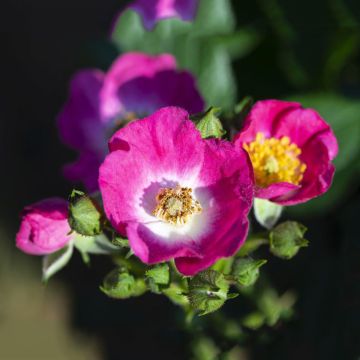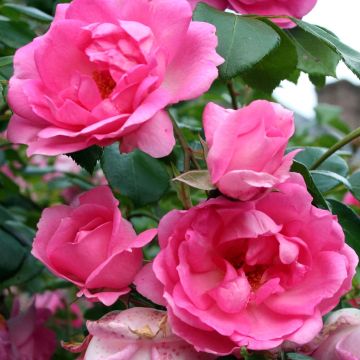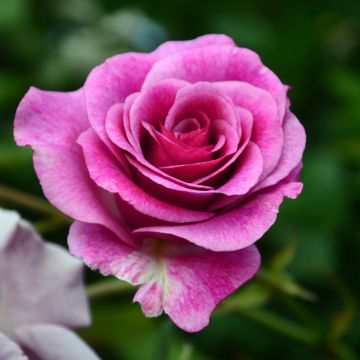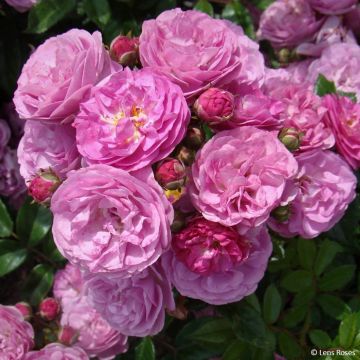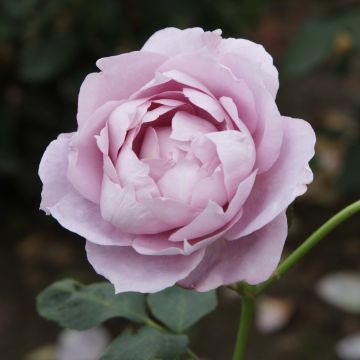

Rosier arbustif White Magic


Rosier arbustif White Magic
Rosa White Magic - shrub rose
Rosa x moschata White Magic 'LENmagi'
shrub rose, musk rose
This item cannot be shipped to the selected country
Delivery charge from €5.90
Delivery charge from €5.90
More information
Schedule delivery date,
and select date in basket
This plant carries a 24 months recovery warranty
More information
We guarantee the quality of our plants for a full growing cycle, and will replace at our expense any plant that fails to recover under normal climatic and planting conditions.
From €5.90 for pickup delivery and €6.90 for home delivery
Express home delivery from €8.90.
From €5.90 for pickup delivery and €6.90 for home delivery
Express home delivery from €8.90.
Does this plant fit my garden?
Set up your Plantfit profile →
Description
Rosa White Magic is a graceful, fresh rose bush that combines the toughness of wild roses with the perpetual flowering of musk hybrid roses. Its single white roses with simple corollas bloom in large clusters, gracefully bending the branches. The slightly scented flowers attract bees and produce small orange-red hips in autumn, sought after by birds. It is a naturally disease-resistant variety, almost maintenance-free, rewarding and easy to grow in any type of soil, even in partial shade. And its flowers are very beautiful in a vase.
Rosa White Magic is a creation by L. Lens dating back to 1989. It is derived, among others, from the musk rose (Rosa (x) moschata), a spontaneous hybrid probably originating from Asia Minor or the Middle East. A bit like polyanthas and floribundas, roses in this family produce flowers grouped in clusters, but their colours are more refined and they have a more flexible and graceful habit. 'White Magic' has rapid growth and a bushy and spreading habit, fanning out. Ultimately, this bush reaches an average height of 1.35 m (4ft) with an almost equivalent spread. Its flexible, thorny stems bear light green, disease-resistant leaves divided into leaflets. Flowering begins in June and continues until October if the soil does not dry out too much and the plant is regularly deadheaded. It blooms in massive clusters of small 3 cm (1in) diameter, pure white, single flowers. The centre of the corollas is occupied by golden stamens, attractive to bees and other pollinators. If the faded flowers are left on the plant from August, this rosebush produces decorative small hips at the end of the season. It is hardy to about -15°C (5°F).
Shrub rose White Magic is undemanding, reliable, and generous. The bush thrives in well-prepared soil and requires no pruning other than removing the oldest branches or dead wood at the end of winter. Unlike many roses, its beauty is not ostentatious. Its lightness and wild rose appearance go well with all the plants in the garden. Plant it in a small flowering hedge or a bed with other roses, perennials such as peonies, iris and tall phlox, or other small flowering shrubs with staggered bloom times: small-sized lilacs (Syringa microphylla superba), mock oranges, or Japanese quinces. Also, consider planting it with a herbaceous clematis.
Report an error about the product description
Plant habit
Flowering
Foliage
Botanical data
Rosa
x moschata
White Magic 'LENmagi'
Rosaceae
shrub rose, musk rose
Cultivar or hybrid
Other Polyantha clustered Roses
Planting and care
The White Magic rose can be planted in the sun, but it also tolerates partial shade, especially in sunny and hot regions. It will thrive in any garden as long as the soil is well-worked and rich. To plant your rose bush, work the soil by digging it well and put a base fertiliser such as bonemeal at the bottom of the planting hole. Water generously after planting to eliminate air pockets and regularly for a few weeks to aid rooting. Pruning is limited to the removal of dead wood, and you can thin out the centre of the bush by pruning the interlocking branches if you wish. Deadhead regularly to stimulate the development of more flowers.
Rose bushes are often stained or unsightly at the end of summer, but this is not a problem for their growth. These stains are not harmful to the rose bush, it is a natural phenomenon.
Planting period
Intended location
Care
-
, onOrder confirmed
Reply from on Promesse de fleurs
Roses by producer
Haven't found what you were looking for?
Hardiness is the lowest winter temperature a plant can endure without suffering serious damage or even dying. However, hardiness is affected by location (a sheltered area, such as a patio), protection (winter cover) and soil type (hardiness is improved by well-drained soil).

Photo Sharing Terms & Conditions
In order to encourage gardeners to interact and share their experiences, Promesse de fleurs offers various media enabling content to be uploaded onto its Site - in particular via the ‘Photo sharing’ module.
The User agrees to refrain from:
- Posting any content that is illegal, prejudicial, insulting, racist, inciteful to hatred, revisionist, contrary to public decency, that infringes on privacy or on the privacy rights of third parties, in particular the publicity rights of persons and goods, intellectual property rights, or the right to privacy.
- Submitting content on behalf of a third party;
- Impersonate the identity of a third party and/or publish any personal information about a third party;
In general, the User undertakes to refrain from any unethical behaviour.
All Content (in particular text, comments, files, images, photos, videos, creative works, etc.), which may be subject to property or intellectual property rights, image or other private rights, shall remain the property of the User, subject to the limited rights granted by the terms of the licence granted by Promesse de fleurs as stated below. Users are at liberty to publish or not to publish such Content on the Site, notably via the ‘Photo Sharing’ facility, and accept that this Content shall be made public and freely accessible, notably on the Internet.
Users further acknowledge, undertake to have ,and guarantee that they hold all necessary rights and permissions to publish such material on the Site, in particular with regard to the legislation in force pertaining to any privacy, property, intellectual property, image, or contractual rights, or rights of any other nature. By publishing such Content on the Site, Users acknowledge accepting full liability as publishers of the Content within the meaning of the law, and grant Promesse de fleurs, free of charge, an inclusive, worldwide licence for the said Content for the entire duration of its publication, including all reproduction, representation, up/downloading, displaying, performing, transmission, and storage rights.
Users also grant permission for their name to be linked to the Content and accept that this link may not always be made available.
By engaging in posting material, Users consent to their Content becoming automatically accessible on the Internet, in particular on other sites and/or blogs and/or web pages of the Promesse de fleurs site, including in particular social pages and the Promesse de fleurs catalogue.
Users may secure the removal of entrusted content free of charge by issuing a simple request via our contact form.
The flowering period indicated on our website applies to countries and regions located in USDA zone 8 (France, the United Kingdom, Ireland, the Netherlands, etc.)
It will vary according to where you live:
- In zones 9 to 10 (Italy, Spain, Greece, etc.), flowering will occur about 2 to 4 weeks earlier.
- In zones 6 to 7 (Germany, Poland, Slovenia, and lower mountainous regions), flowering will be delayed by 2 to 3 weeks.
- In zone 5 (Central Europe, Scandinavia), blooming will be delayed by 3 to 5 weeks.
In temperate climates, pruning of spring-flowering shrubs (forsythia, spireas, etc.) should be done just after flowering.
Pruning of summer-flowering shrubs (Indian Lilac, Perovskia, etc.) can be done in winter or spring.
In cold regions as well as with frost-sensitive plants, avoid pruning too early when severe frosts may still occur.
The planting period indicated on our website applies to countries and regions located in USDA zone 8 (France, United Kingdom, Ireland, Netherlands).
It will vary according to where you live:
- In Mediterranean zones (Marseille, Madrid, Milan, etc.), autumn and winter are the best planting periods.
- In continental zones (Strasbourg, Munich, Vienna, etc.), delay planting by 2 to 3 weeks in spring and bring it forward by 2 to 4 weeks in autumn.
- In mountainous regions (the Alps, Pyrenees, Carpathians, etc.), it is best to plant in late spring (May-June) or late summer (August-September).
The harvesting period indicated on our website applies to countries and regions in USDA zone 8 (France, England, Ireland, the Netherlands).
In colder areas (Scandinavia, Poland, Austria...) fruit and vegetable harvests are likely to be delayed by 3-4 weeks.
In warmer areas (Italy, Spain, Greece, etc.), harvesting will probably take place earlier, depending on weather conditions.
The sowing periods indicated on our website apply to countries and regions within USDA Zone 8 (France, UK, Ireland, Netherlands).
In colder areas (Scandinavia, Poland, Austria...), delay any outdoor sowing by 3-4 weeks, or sow under glass.
In warmer climes (Italy, Spain, Greece, etc.), bring outdoor sowing forward by a few weeks.


































